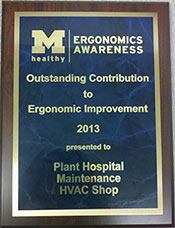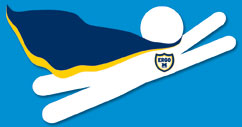Recognize a university unit or department that has independently created a safer, healthier and more efficient work environment by decreasing ergonomic risk factors and reducing or preventing employee discomfort. Nominations accepted throughout the month of March.
Questions? Email MHealthy Ergonomics Awareness at [email protected] or call (734) 763-0852.
Nominate a department or unit for an Ergonomics Department Award.
Department Awards Questions and Answers
- What are the MHealthy Ergonomics Department Awards?
- "Gold" level department(s) or unit(s) will receive a special plaque of recognition.
- "Silver" level receive(s) a special certificate of recognition.
- "Bronze" level receive(s) a special letter of appreciation (not shown).
- "Gold" Level Plaque

- "Silver" Level Certificate

- What kind of projects will be considered for an Ergonomics Department Award?
- Entries may include new equipment, equipment modifications, or work process redesigns that can document successful reduction in one or more of the following ergonomic risk factors:
-
- Awkward Postures: Posture is the position your body is in while muscle groups are involved in physical activity. Awkward postures include repeated or prolonged reaching, twisting, bending, kneeling, squatting or, working overhead with your hands or arms.
- Forceful Exertions: Force is the amount of physical effort required to perform a task, such as heavy lifting or maintaining control of equipment or tools. The amount of force depends on the type of grip, the weight of an object, body postures, the types of activity and the duration of the task.
- Repetition or Sustained Postures: Doing the same motions over and over again or holding the body in one posture for long periods of time places stress on the muscles and tendons. The severity of risk depends on how often the action is repeated, the length of time postures are maintained, the speed of the movement, the number of muscles involved, and the force required.
- Contact Stress: Pressing the body against a hard or sharp object can result in putting too much pressure on nerves, tendons, and blood vessels. For example, using your hand as a hammer can increase your risk of MSD (musculoskeletal disorders).
- Vibration: Operating vibrating tools such as sanders, grinders, chippers, routers, drills and saws can lead to nerve damage. Special padding or anti-vibration gloves can help.
- Temperature Extremes: Temperature extremes can also influence the magnitude of risk factors. As an example, the use of thick or loose-fitting gloves to keep hands warm may cause you to grip hand tools more forcefully, resulting in added stress to the wrists and hands. Similarly, a hot environment may decrease endurance and may increase the slipperiness of hand tools due to sweating.
Note: These products are typically excluded from the department award process:
-
Ball chairs
-
Small office items (keyboards, mice, etc)
-
Sit/stand workstations
-
Treadmilll Workstations
The team does support and encourage the healthier alternative: That faculty and staff move as able, at least hourly for about 3 minutes, and build other movement into their workday activities.
- Who is eligible to receive a Department Ergonomics Award?
- Any University of Michigan department, (excluding the ergonomics consultants’) or unit that implemented an effective ergonomic solution in the prior year is eligible for this award program. However, Award nominations will not be considered for projects previously funded by the MHealthy Ergonomics Grants program.
- Who can submit nominations for an Ergonomics Hero Award?
- Any faculty or staff member can submit a nomination form.
- Can I nominate a department or unit I don’t work for?
- Yes.
- Who are the judges?
- The judging panel is comprised of the MHealthy Ergonomics Awareness Team, consisting of health and safety personnel from MHealthy, UMHHC Safety Management Services, EHS Ann Arbor, and the Environment, Health and Safety Offices in Flint and Dearborn.
- What criteria will the judges use to evaluate Ergonomics Department Award nominations?
-
- Significance of the ergonomic issue
- Successful outcome of the ergonomics solution
- Inclusion of the staff in the problem identification and solution development process
- What will a department receive for winning an Ergonomics Department Award?
- There are typically three levels of awards, similar to the Olympics’ Gold, Silver and Bronze medals. The prize may vary by year, and depends upon the projects submitted.
-
- The “Gold” level department(s) or unit(s) will receive a special plaque of recognition.
- The “Silver” level receive(s) a special certificate of recognition.
- The “Bronze” level receive(s) a special letter of appreciation.
- Projects that do not qualify receive an explanatory email.
- All award recipients will be notified by email by May, and they will also be recognized in the university community and on the MHealthy website.
- How do I submit a nomination for a Ergonomics Department Award?
- The nomination form is online year round to accept nominations, and they are reviewed once per year in April.

- Submit a Ergonomics Department Award nomination.